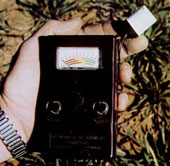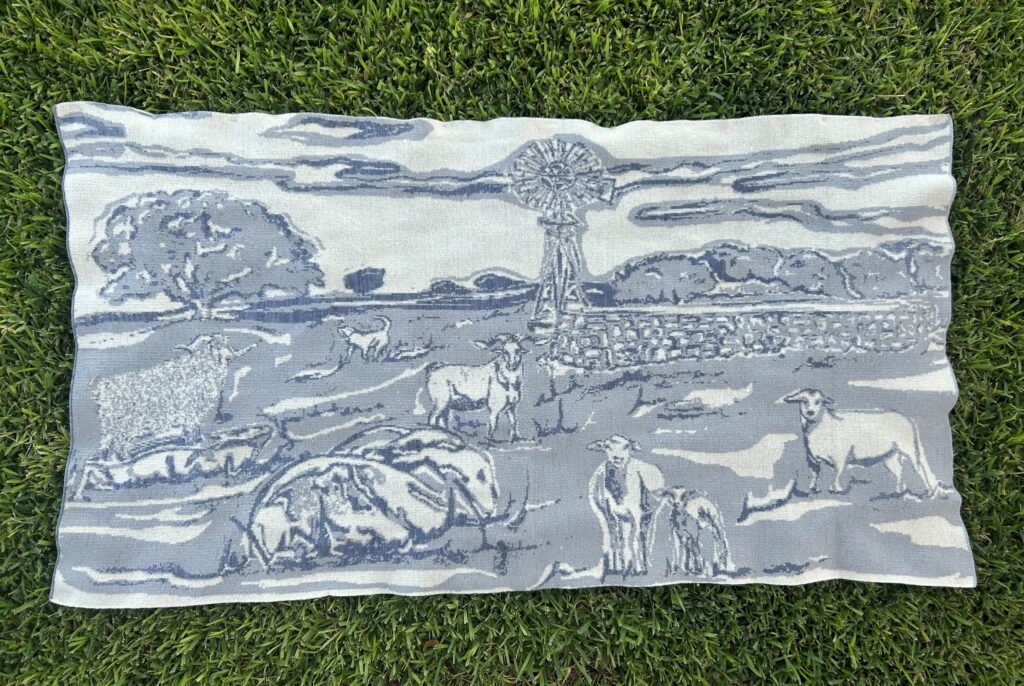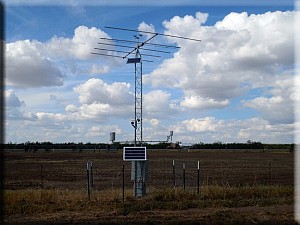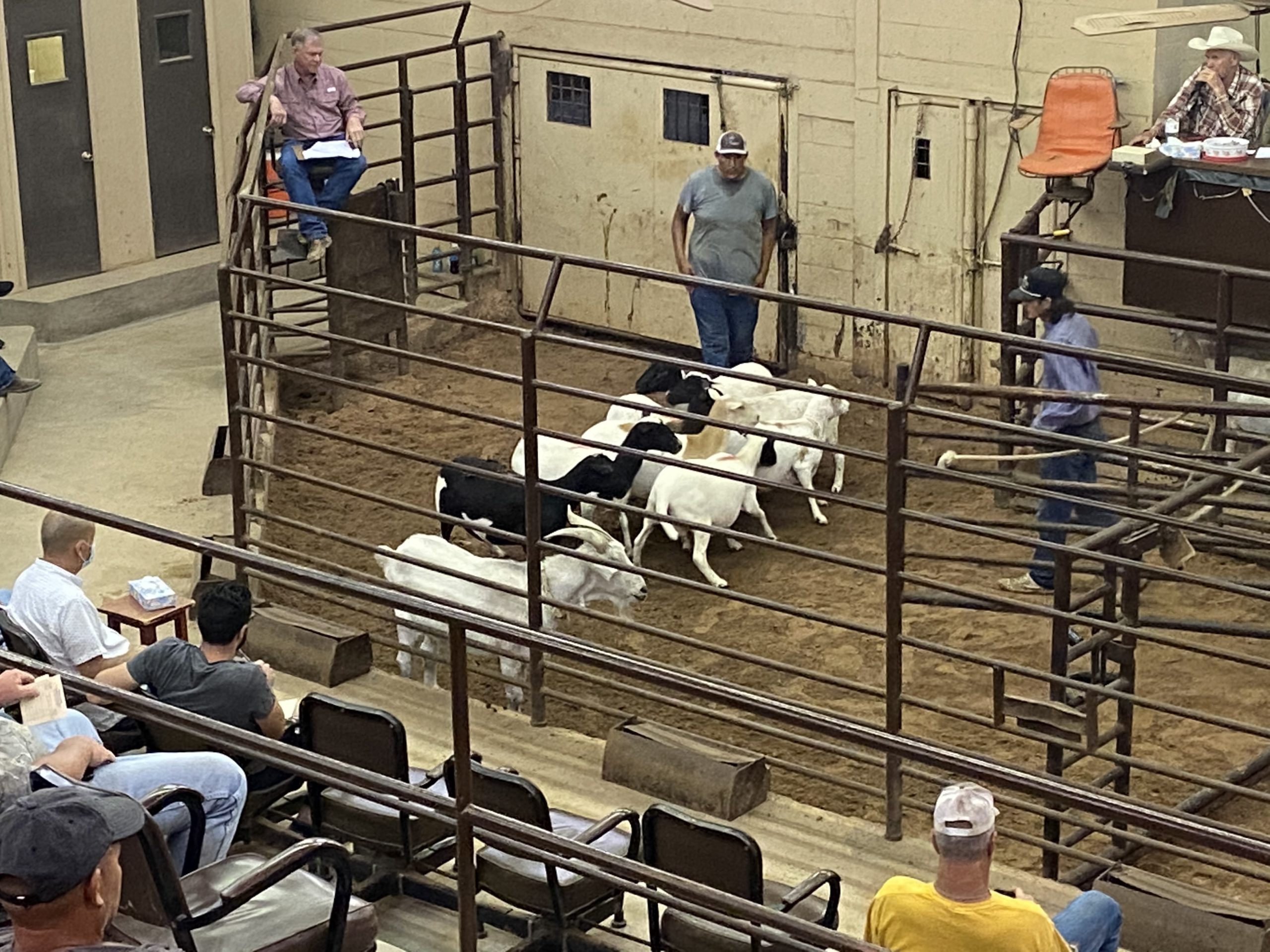Installation
Soil moisture blocks are installed after crop emergence and are buried in the root zone soil profile. If an auger is used to dig the hole, four blocks can be installed in the same hole at one foot depth intervals. However, care should be taken to backfill and pack the soil around each of the blocks in the same order it was removed from the hole. Each block should be soaked in water just before it is installed in the hole. It should be dripping wet as it is placed in the hole.
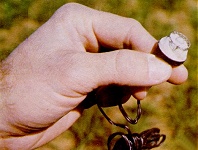 Cut away the gypsum and the stainless steel electrodes which make up the core of the soil moisture block is revealed. An indication of soil moisture is obtained through the electrical resistance which occurs between these electrodes.
Cut away the gypsum and the stainless steel electrodes which make up the core of the soil moisture block is revealed. An indication of soil moisture is obtained through the electrical resistance which occurs between these electrodes.
One of the most commonly used soil moisture monitoring tools is the moisture block used with a conductance meter. Most moisture blocks are made by casting an inch-long cylinder of gypsum around two stainless steel electrodes with lead wires trailing.
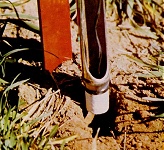 Installing four soil moisture blocks in one hole requires care and attention to detail. One block should be lowered into the hole then a mud mixture is placed around the block. Next, the native material that was removed from the hole above the depth the block was installed is packed into the hole until it is filled to the level for the next block. This is repeated for each block.
Installing four soil moisture blocks in one hole requires care and attention to detail. One block should be lowered into the hole then a mud mixture is placed around the block. Next, the native material that was removed from the hole above the depth the block was installed is packed into the hole until it is filled to the level for the next block. This is repeated for each block.
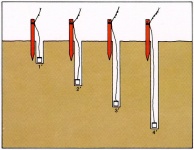 Blocks can also be installed with each block in a separate hole. Here four blocks have been placed in individual holes and the lead wires trailing to surface have been tied in knots to indicate the depth at which the block is buried.
Blocks can also be installed with each block in a separate hole. Here four blocks have been placed in individual holes and the lead wires trailing to surface have been tied in knots to indicate the depth at which the block is buried.
When a push tube or drive rod is used to make the hole, only one block should be used in each hole. Each block should be pressed into the bottom of the hole. These types of holes may be backfilled and packed with surface soil.
Taking Readings
Wires from the buried blocks are connected to a stake at ground surface and coded to indicate the depth at which the block is buried. Tie one knot in the wire for the block buried at the one foot level, two knots in the wire for the block buried at the two foot level, etc. These wires are connected to a small, hand-held resistance meter for readings.
The meter measures electrical resistance and displays it as a percent of field capacity value. Electrical resistance varies with the amount of moisture in the soil. A reading of “0” is dry and a “10” is wet.
Moisture blocks help the irrigator determine what is occurring in the root zone soil moisture profile and see from what depth his crop is extracting moisture, as well as, how much moisture is being extracted.
Irrigators should take special care to monitor the effects of rainfall on soil moisture conditions. Summer rainfall events can be very deceptive. The top six inches of the soil generally is weather dried and requires an extra measure of water to rewet to field capacity.
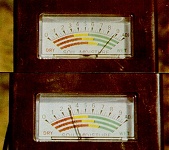 The dial on an electrical resistance meter reads from “0” which indicates dry soil moisture conditions to “10” which indicates a full soil moisture profile. The top reading of 9 would show a moisture condition near field capacity, while the bottom meter reading of 3 would indicate soil moisture that is relatively dry.
The dial on an electrical resistance meter reads from “0” which indicates dry soil moisture conditions to “10” which indicates a full soil moisture profile. The top reading of 9 would show a moisture condition near field capacity, while the bottom meter reading of 3 would indicate soil moisture that is relatively dry.
Keys to Success
The key to successful use of soil moisture blocks is making frequent readings to indicate crop root development and soil moisture conditions at each foot of depth. Good records should be kept of block readings, with notations as to crop development stages and weather conditions.
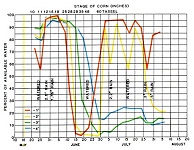 Monitoring soil moisture throughout a growing season could result in a graph of readings like that pictured to the left. Attention is given to aspects of crop growth, rainfall and irrigation applications. Crop water use is seen in the line dips. Note that neither rainfall nor irrigation amounts were adequate to wet the three and four foot levels during the last part of the growing season.
Monitoring soil moisture throughout a growing season could result in a graph of readings like that pictured to the left. Attention is given to aspects of crop growth, rainfall and irrigation applications. Crop water use is seen in the line dips. Note that neither rainfall nor irrigation amounts were adequate to wet the three and four foot levels during the last part of the growing season.
Summary
This system has a relatively low cost and allows measuring the same field location throughout the season. New blocks must be installed each growing season because gypsum dissolves and the wires are usually destroyed during land preparation and planting activities. The level of accuracy obtainable with resistance blocks, while not perfect, is sufficient for making most irrigation water management decisions.
Acknowledgements
This information was written by Ken Carver and A. Wayne Wyatt, High Plains Underground Water Conservation District No. 1 and Mike Risinger, USDA-NRCS

